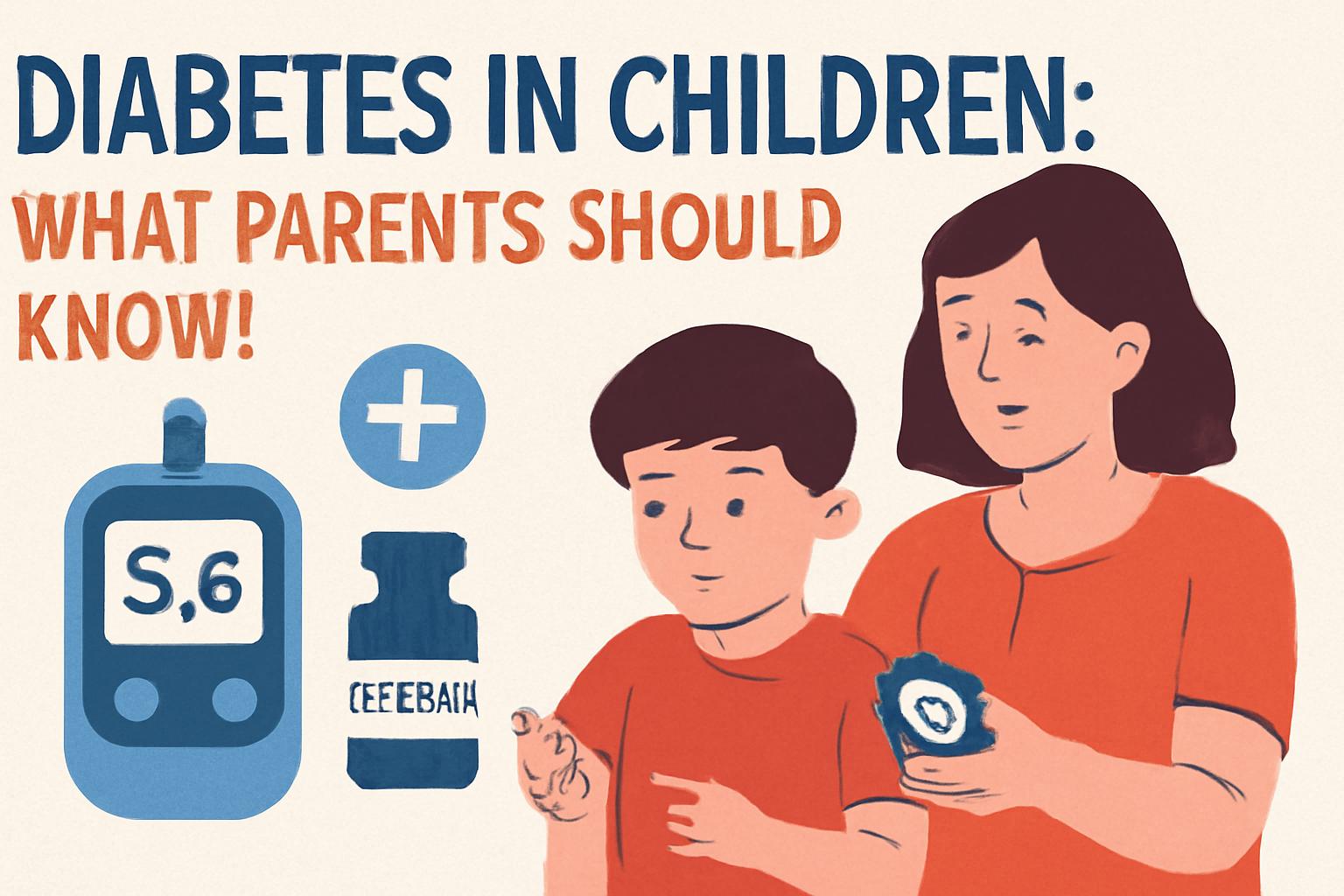Diabetes in Children: What Parents Should Know!

At first, raising a child with diabetes may seem daunting. Your love, attention to detail, and direction as a parent can make all the difference. This article aims to give this medical journey a human touch by assisting you in understanding symptoms, treatment, everyday care, and emotional support.
1. Know the Signs Early
Early recognition of diabetes symptoms is vital, especially for type 1 diabetes, the most common in children. Look out for:
- Extreme thirst & frequent urination (night or day)
- Unexpected weight loss despite a good appetite
- Fatigue, irritability, or mood swings
- Blurred vision, headaches, or nausea
- Bedwetting after a period of dryness
If your child shows multiple signs, seek medical attention immediately. Left untreated, type 1 diabetes can escalate into diabetic ketoacidosis (DKA), a serious condition requiring urgent care.
2. Understand the Types of Diabetes
Type 1 Diabetes: An autoimmune attack on insulin-producing cells—children depend on daily insulin injections or pumps .
Type 2 Diabetes: Less common in kids, but rising due to obesity and inactive lifestyles. It’s driven by insulin resistance and often managed with diet, exercise, and medication.
Monogenic and others: Rare, genetic forms needing tailored care from specialists.
3. Diagnosis & Treatment
Diagnosis: Blood tests—fasting glucose, HbA1c levels, or an oral glucose tolerance test. Abnormal readings are early signals.
Insulin therapy: Daily injections or an insulin pump replace what their body cannot produce.
Blood sugar monitoring: Via finger-prick tests or continuous glucose monitors (CGM)
Balanced nutrition: Managed by a dietitian, focusing on whole grains, lean proteins, veggies, and healthy fats. Counting carbs becomes part of daily life.
Physical activity: Regular play and exercise help manage blood sugar. Parents should monitor glucose levels before and after activities to prevent low blood sugar
4. Daily Management
Put a schedule in place for meals, snacks, blood tests, insulin, and sleep.
Teach older children how to self-administer insulin and recognize blood sugar fluctuations.
Keep snacks and glucose sources handy during school or outings.
Communicate with caregivers, teachers, and coaches—provide a management plan and supplies to ensure safety and continuity.
5. Emotional & Social Support
Managing diabetes isn’t only physical—it’s emotional:
Create a safe, open atmosphere where your child feels comfortable sharing emotions.
Encourage age-appropriate independence, boosting confidence.
Connect with support networks—parent groups, local diabetes camps, or mentorship from experienced families.
Validate feelings and fears, and celebrate small successes along the way.
Also Read: Glucotrust Official Website
6. Preventing and Handling Complications
Well-managed diabetes can resemble a healthy childhood, but complications may arise if blood sugar remains uncontrolled:
Short-term risks: Hypoglycemia (low blood sugar) and hyperglycemia (high blood sugar) can happen with illness, stress, or hormonal shifts.
Long-term risks: Delays in care may affect the kidneys, eyes, nerves, gums, and heart .
Oral health: Children with diabetes are more susceptible to gum disease, dry mouth, and delayed healing .
Prevention: Regular medical and dental check-ups are crucial.
7. Nourishing Meals & Smart Snacking
Balanced nutrition is key:
Emphasize nutrient-rich foods—whole grains, colorful vegetables, lean proteins.
Learn to count carbohydrates to fine-tune insulin doses.
Limit processed foods and sugary drinks.
Treats can still be part of life—just in controlled servings with proper insulin adjustments.
8. Active Play & Fitness
Play isn’t just fun—it’s therapeutic:
Aim for at least 60 minutes of physical activity daily.
Monitor blood sugar before, during, and after activity.
Provide quick-access carbs during exercise to prevent lows.
Engagement in sports or active hobbies promotes both physical and emotional wellness.
9. Coordinate with Your Healthcare Team
A supportive healthcare team makes a world of difference:
Pediatric endocrinologists, dietitians, diabetes educators, and mental health professionals.
Frequent consultations help refine treatment, adjust insulin, and address emotional or social dynamics.
Stay updated on new technologies like advanced insulin pumps and closed-loop systems.
10. Empowering Your Child
Involve them in care routines early—testing, insulin prep, carb counting.
Use positive reinforcement to build good habits.
Celebrate achievements, like managing highs/lows or trying a new food.
Encourage self-advocacy—talking with teachers, peers, or coaches about diabetes.
Final Thoughts
Parenting a child with diabetes involves education, empathy, and unwavering support. Here’s a quick checklist:
- Watch for early symptoms.
- Create a consistent daily routine.
- Embrace a healthy, balanced lifestyle.
- Teach and encourage self-care and independence.
- Stay proactive about complications and emotional needs.
- Involve a caring healthcare team.
With your love, patience, and knowledge, your child can thrive with diabetes. Let each day be a celebration of growth, resilience, and empowerment—and remember, you're never alone on this path. You must try Glucoberry.
Note: IndiBlogHub features both user-submitted and editorial content. We do not verify third-party contributions. Read our Disclaimer and Privacy Policyfor details.




